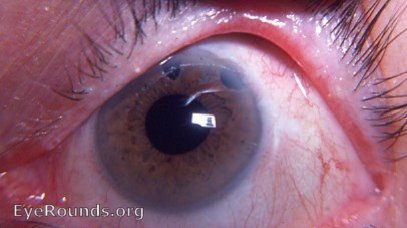EyeRounds Online Atlas of Ophthalmology
Contributor: William Charles Caccamise, Sr, MD, Retired Clinical Assistant Professor of Ophthalmology, University of Rochester School of Medicine and Dentistry
*Dr. Caccamise has very generously shared his images of patients taken while operating during the "eye season" in rural India as well as those from his private practice during the 1960's and 1970's. Many of his images are significant for their historical perspective and for techniques and conditions seen in settings in undeveloped areas.
Category: Cataract
Perfect intracapsular cataract operation with two peripheral iridectomies - a part of cataract surgery's history

The photo shows a perfect intracapsular result with two peripheral iridectomies. " A simple extraction " meant that no iridectomy was performed as part of the operation. Such extractions normally were not considered acceptable. " A compound extraction " meant that an iridectomy was performed as part of the operation. There were four approaches to the iris during the operation: 1. one or more peripheral iridectomies, 2. a complete (sector) iridectomy, 3. an iridotomy, 4. leave the iris totally intact- an approach that was generally unacceptable. Why was an iris opening of some type considered de rigueur? The two reasons were: 1. an opening in the iris discouraged iris prolapse postoperatively. Postoperatively aqueous humor might gush out of a leaky wound. In doing so, it might carry the intact iris ahead of it - thus producing an iris prolapse. An opening in the iris would offer a free pathway for the exiting aqueous - there would be no intact iris to push through the wound. 2. an additional justification for the iris opening appeared with the explanation of pupillary block glaucoma. With an opening in the iris, pupillary block was obviated. As an added note, the iris openings were performed superiorly so that they would be covered by the upper lid. This reduced photophobia and dazzling that might result from uncovered iris openings. It also decreased any significant cosmetic effect. As a matter of semantics: photophobia is an unpleasant reaction to a normal amount of light. Dazzling is an unpleasant reaction to an excessive amount of light.

Ophthalmic Atlas Images by EyeRounds.org, The University of Iowa are licensed under a Creative Commons Attribution-NonCommercial-NoDerivs 3.0 Unported License.


